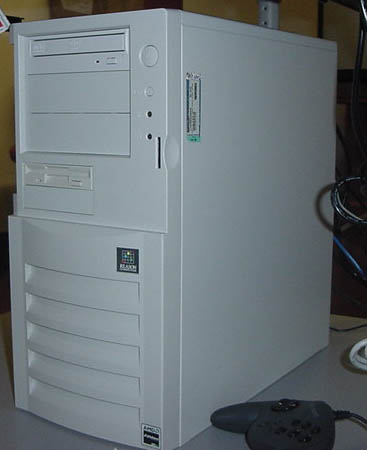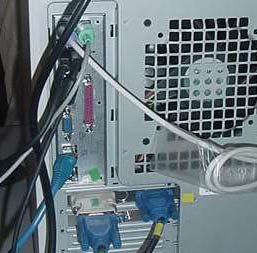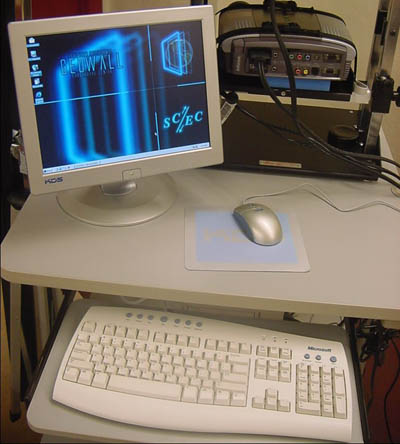|
The Computer

Because they had previous experience, we decided to go
with Reason Computers in Minnesota.
The final computer cost us $3594.
Essentially, there's nothing too special about the Geowall
computer. It's a regular desktop, beefed up to handle graphics and fast
processing. The one key element is the video-card, which must have dual
video outputs. It is these outputs that will make projecting different
images for the left and right eye possible.
We chose
the NVIDIA PNY Quadro 4-750 128 MB DDR Twin. In order to run large
graphics applications and render very large datasets, we had 2048 MB of DIMM RAM
installed, as well as a quick 1.6GHz dual-processor.

Dual Video Output Seen Here
We also purchased a 15" flat panel computer monitor which
allows us to use the computer without needing to project the screen. The LCD screen projects polarized light, which means that if
you are wearing the polarizing glasses you will only be able to see the monitor
with one eye.

The Computer Interface: Monitor, Keyboard, Mouse
We originally intended to have two operating systems on
the computer. We had Windows 2000 preinstalled and were going to install
Linux on the second hard-drive. Although we haven't done this yet, when
and if we do, we will make use of the two hard-drives that we have, installing
one OS on each, and making the Linux drive a slave to the Windows drive.
From Russ Burdick:
best bet is to use one drive for windows (the primary master hd) and the
other for linux (make it the primary slave hd). the windows drive can go
pretty much however you want, but linux can read+write to fat partitions (all
flavors) and only read from ntfs. this means that you'll probably want to
split it so that you've got a ntfs partition for the win2k install (which
linux can read, not write) and the rest of the drive fat32 so that linux can
read and write to it. the second hard drive should be partitioned with a small
partition at the begining for /boot (around 100MB would be more than enough),
a fairly large partition for / (around 15GB), almost everything else for a
'work' area (typically we mount this one at /usr/share/demos and make it most
of the rest of the disk, so about 62GB), and then the remaining 2GB should be
for a swap partition. linux wont let you make larger than a 2gb swap partition
last i checked, so you'll probably want to adjust the size of the 'work'
partition until you have around or slightly less than 2gb left at the end.
optionally, you can do only three partitions with the same 100MB /boot
partition and 2BG swap, but make the remainder /.
Complete Specs from Reason Computers:
|
Item Geowall Fixed Dual |
Description |
|
|
|
0 |
|
|
|
|
Case |
Triple Bay Tower for Dual Athlon w/430Watt PS SR20505 |
|
Power Supply |
430 Watt Single PS |
|
|
|
CPU |
1.60GHz 1900+ MP 266FSB |
|
|
Motherboard |
Tyan S2462NG w/o SCSI |
|
|
RAM |
2-1024MB DDR266MHz 2048MB DIMMs |
Reg ECC |
|
Video |
NVIDIA PNY Quadro 4-750 128MB DDR Twinview DVI/AGP |
ATI |
|
Sound |
Onboard |
|
|
|
NIC |
Integrated 10/100 NIC |
Dual Server NICs |
|
Modem |
None |
|
|
|
Floppy |
Mitsumi 3.5" Floppy |
|
|
|
Hard Drive |
80GB (7200rpm) ATA/100 |
|
|
2nd HD or Accessories |
80GB (7200rpm) ATA/100 |
|
|
CD-ROM |
Combo CDRW/DVD Drive 12x8x32x8 |
|
|
2nd CD ROM |
None |
|
|
|
Other Storage Devices |
None |
|
|
|
Storage Media |
None |
|
|
|
Keyboard |
Microsoft Internet Keyboard |
|
|
Mouse |
Microsoft Intellipoint PS/2 Mouse |
|
|
Speakers |
None |
|
|
|
Monitor |
15" Flat Panel LCD Monitor |
|
|
Printer |
None |
|
|
|
Print Cartridges |
None |
|
|
|
Operating System |
Windows 2000 Profesional |
|
|
Other Software |
None |
|
|
|
Case Label |
Standard Reason Label |
|
|
Box Label |
Reason Box w/ Reason Label |
|
Back
|